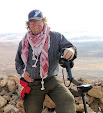We have three large redoubts on the eastern hill, and hundreds of metres of separate breastwork trenches on the northern hill. The metal detectorists have recovered spent Ottoman Mauser and Arab 303 rounds and cartridges, over several square kilometres of ground. Why is Wuheida so heavily contested? Almost certainly because it lies close to Ma’an on the road to Aqaba, captured by the Arabs in July 1917, making this area a major theatre of operations until February 1918.
Within the complexes the stone architecture unfolding is quite different from previously viewed Ottoman sites encountered, and is clearly the stone outlines of Arab encampments, distinctly different from those at Bat’n Al Ghul, Fassuah and others. The finds themselves however are a total mix of both German/Ottoman and Arab/Anglo/French origin, particularly in the armaments. Finds have included Mauser cartridges and clips, 303 cartridges and clips, Lebel cartridges, British military buttons, British shirt buttons, spoon fragments, buckles and belt ends, decorated metal box lids, artillery shell case fragments, boot heel plates and more.

The team working on the northern hill have been busy excavating the interiors of 3 square stone built structures inside one of the Ottoman redoubts. At present most of the finds appear to be Arab. Excavators are removing rubble and then troweling and brushing to expose original floor surfaces. The portable material finds from these structures are Arab, resting on the permanent structures, the architecture of which is likely to be Ottoman.
These are exciting times for GARP – more sites unfold every day and the team, although very tired from the daily activities in the desert, are enthused and driven onward by the ever unfolding history of this conflict landscape.
(more pictures to follow)










No comments:
Post a Comment